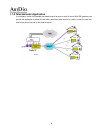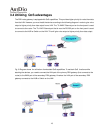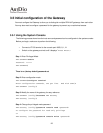
16
3.3 Working Under a NAT Networking Environment
IP addresses are limited; because of this, not all devices on the Internet can have their own public IP
address. An application is available that allows users to use a private IP address by utilizing a NAT (Network
Address Translation) server. When the packets are sent out from the local area network, the IP header will
be replaced with a public IP address. This is very useful in conserving IP address usage on the Internet.
Most VoIP devices cannot support NAT , since NAT servers only replace the IP headers. However, VoIP
packets have IP information in the data area of every voice packet. So while the voice packet has been
replaced with a real IP header, the data inside is still using a private IP address.
The PBX Gateway is able to use private IP addresses by applying NAT. Most of time, you will not need to
change any configuration settings on the NAT server or even on the PBX Gateway itself. The one essential
condition is that the master device of the group should use a public IP address.
Since there are currently so many NAT servers on the market , there is no set standard in addressing how
to develop NAT servers or how to test the interoperability of NAT servers with other applications. Therefore,
depending on your NAT server, you may have to adjust some of the configurations to specify the
In-bound/Out-bound rules in order to give your NAT server the ability to work with various special
applications.
Fig 8 Supports VoIP under a NAT environment
Guaranteed only for tested NAT servers or software
Some of the NAT configuration settings need to specify the In-bound/Out-bound rules, however


















